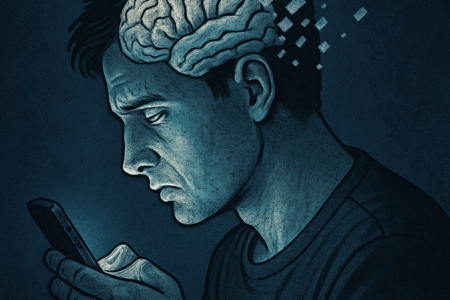In the last blog, we talked about a new emerging disorder, which is digital Dementia. Digital Dementia is the phenomenon where the increased screen time and constant connectivity play a grave role in affecting a person’s health. In an era that is dominated by screens, notifications, and constant connectivity, Digital Dementia has emerged as a silent yet pressing cognitive health concern. Coined by neuroscientists to describe the cognitive decline, particularly in memory, attention, and concentration, caused by over-reliance on digital devices, digital dementia is no longer limited to the elderly or the tech-obsessed. It is now affecting young adults, teenagers, and even children. But the good news is that digital dementia can be undone. The term coined by neuroscientists to describe the significant decline, particularly in memory, attention, and concentration, caused by over-reliance on digital devices, digital dementia is no longer limited to the elderly, the poor the tech-obsessed. It’s now affecting young adults, teenagers, and even children. Let us have a look at how effectively we can get rid of the newly emerged digital dementia issue. It is possible to rewire our brains for better focus, memory, and overall cognitive resilience. Let’s explore some practical, science-backed solutions to combat this modern-day mental drain. Digital Detox: The First Step to Recovery One of the most effective ways to overcome the problem of Digital dementia is simply reducing screen time. By reducing your screen time, you can get rid of the blue light, which is harmful to your eyes, back, and brain’s growth. It might feel overwhelming to just stop using the phone all of a sudden, but you can start small. Set daily limits on smartphone use. Designate “no screen” zones at home, especially the bedroom and dining areas. You can even take regular breaks using the 20-20-20 rule: every 20 minutes, look at something 20 feet away for every 20 minutes, look at something 20 feet away for 20 seconds. If you are someone who works online, scheduling short, structured digital detents over weekends or during vacations can dramatically improve your brain function, creativity, and emotional well-being. Think of it as giving your brain time to breathe. Start with Memory Training and Brain Exercises Our brains are like muscles- they get stronger with use. With smartphones acting as our external memory drives 9think saved passwords, reminders, GPS directions), we have stopped exercising our natural memory skills. To feel in charge of your brain and get active, it is crucial to reclaim these abilities. Start with brain-training exercises such as: Memorizing phone numbers or grocery lists, Playing cognitive games like Sudoku, chess puzzles, and reading a page of your favourite novel. Practicing mental math instead of reaching for a calculator also signifies brain activity. Engaging in these activities improves neuroplasticity—the brain’s ability to form and reorganize synaptic connections—effectively reversing some effects of digital dementia. 3. Read Physical Books and Write by Hand Book Readers are preferring to read books in PDF format to save the hassle of purchasing books from different vendors and shops. Reading books in print rather than on a screen promotes deep reading and comprehension-something skimming articles online does not offer. Writing things down by hand, whether journaling, note-taking, or sketching, activates areas of he brain responsible for learning and retention. Studies show that people who write things down manually remember information better than those who type it. So, the next time you need to remember a task or an event, ditch the notes app and pick up a diary. 4. Mindfulness and Meditation Mindfulness practices are powerful tools for strengthening attention and memory. Just 10 minutes of daily meditation can improve focus, reduce anxiety, and even reshape brain regions responsible for cognitive control. Practicing mindful breathing, where you focus on your breath and gently bring your attention back when your mind wanders. This simple habit can train your brain to be more present and less distracted. 5. Physical Exercise and Outdoor Activities Exercise regularly improves blood circulation to the brain, lifts mood, and aids memory. Walking, yoga, or dance not only activate the body but also get the brain to disconnect from screen overstimulation. Spending time outdoors has the additional advantage of sensory diversity—something the brain desires but lacks in repetitive digital life. Nature walks, gardening, or even sports can improve concentration and mental acuity. 6. Social Interaction and Real-Life Conversations Over-dependence on digital communication can lead to social withdrawal and emotional fatigueon digital communication can lead to social withdrawal and emotional fatigue. Rebuilding real-world connections through face-to-face conversations, community events, or simple daily interactions helps stimulate emotional intelligence, empathy, and memory. Talking, listening, and engaging with others offline gives the brain the challenge and stimulation it needs to stay agile. Digital dementia is the issue of the modern age, it is not a life sentence. It is a wake-up call. It reflects how modern convenience can come at a cognitive cost- but also how simple conscious choices can help us reclaim our focus, memory, and mental balance. By integrating digital discipline with real-world cognitive practices, we can future-proof our brains and stay sharp in a world that never sleeps. Keep Reading Foramz for your daily dose of moral support.
This is Foramz, and we are discussing the issue of the digital age: Digital Dementia today. Has it ever happened to you that you are trying to remember your best friend’s phone number, but you can’t? You can not even recall your number without checking your phone. Earlier in life, you used to remember birthdays, shopping lists, and directions- now it all lives inside your device. Is this something that you relate to? Welcome to the age of digital dementia. Digital Dementia is a term used to describe how our heavy dependence on digital devices is making our memory, cognitive, and brain power weaker, especially when it comes to things we used to remember ourselves. Let us understand the condition of Digital Dementia. Digital Dementia is not a medical condition like Alzheimer’s or traditional dementia. It is a phrase created by neuroscientists to explain how excessive screen use and technology reliance can make our brains lazy. It is noticeable in young people, who are spending more and more time on phones with increasing screen time day by day. In today’s technology-driven world, we are surrounded by digital devices right from the time we wake up till we go back to sleep at night. This scenario is detrimental and affects our memory and cognitive function. Due to long periods of screen time, there is an effect on the brain’s cognitive functions. This happens due to the decreased attention span and prolonged screen time, which often involves sitting in a difficult posture on the bed or couch. The posture includes a lying position slumped neck, and back. This can cause various This can cause various health-related problems, such as obesity, body aches, spine problems, and backaches. We are not using all of our neuronal channels in the brain as much, which can lead to excessive anxiety, stress levels, and possible changes in behavioral patterns. Why is Digital Dementia so common? There are a few key reasons why digital dementia is becoming more common, including too much screen time. Constant use of smartphones, tablets, and computers means less time spent on things that naturally challenge the brain. Naturally challenging brain includes engaging in reading, puzzles, and real conversations. Another major reason is that the lack of physical activity, movement, and exercise stimulates brain health. Sitting with screens all day reduces this. Reducing face-to-face conversations is also a reason for digital dementia. In the age of online meetings, FaceTime, and calls, it has become convenient to talk to loved ones. Even if we have an option to meet someone in real life, we choose to talk on or phone rather than moving out of the house.: Real conversations help build emotional intelligence and memory. Texting doesn’t give your brain the same amount of workout. How to know if you have digital dementia? People who are experiencing digital dementia may notice forgetting simple things, like names, dates, or where they left something, difficulty focusing on one task, feeling mentally tired or foggy, having shorter attention spans, and lastly, having a poor sleep quality due to screen use before bed. Technology is amazing – it makes life easier, faster, and more connected. But when we rely on it for everything, especially things our brains are designed to do, we risk losing some of our natural abilities. Digital dementia is a wake-up call to balance our digital and real lives and give our brains the workout they deserve. Your phone is smart, but your brain is smarter. Don’t let it forget how powerful it is. Even students and young professionals who use screens for hours each day are showing signs typically seen in older adults, which is alarming. If you are someone with digital dementia, worry not, because in the next episodes, we will be talking about how to overcome digital dementia and slowly return to the state of peace, nature, and love. Keep Reading Foramz for you daily dose of Moral Support.
Social Media is an increasing concern in today’s world. With increased influencers, brand deals, and dopamine kicks, social media proves to be a hazard to teenagers’ health. The Indian Parliamentary panel has been struggling to find a solution to this issue. In a recent turn of events on May 6th, the Parliamentary Standing Committee on Communications and Information Technology wrote to the Ministry of Electronics and IT and the Ministry of Information and Broadcasting. After the Pahalgam terror attack, a parliamentary panel has asked the government to furnish details on the action it plans to take against social media platforms and influencers who seem to be working against the interest of the country, which is likely to incite violence.” The Parliamentary Standing Committee on Communications and Information Technology wrote to the secretary, Ministry of Electronics and IT, and the secretary, Ministry of Information and Broadcasting, seeking these details. The office memorandum from the panel, say sources, requested the ministries for details of ‘contemplated action taken to ban such platforms under IT Act 2000 and Information Technology (Intermediary Guidelines and Digital Media Ethics Code) Rules, 2021’. The sources said that the panel has sought this information by May 8, 2025. BJP MP Mr. Nishkant Dubey headed to the parliament’s Standing Committee on Communications and Information Technology. There have been as many as 26 people who were killed in the April 22 Pahalgam terror attack, and there has been a rise in cross-border hostility between India and Pakistan after the incident. X handles of several Pakistani political leaders, including Defence Minister Khawaja Asif, Minister Abdullah Tarar, former Prime Minister Imran Khan, and former minister Bilawal Bhutto, have been withheld in India as tensions between the two nations remain high. Several FIRs were filed against social media users over their comments about the Pahalgam terrorist attack. Security agencies across the country remain on high alert as tensions escalate between the two nations following the attack. Accusing Pakistan of fostering cross-border terrorism, India has announced a series of punitive measures, including cancelling visas for Pakistani nationals, closing the border and airspace, downsizing diplomatic missions, suspending trade, and putting the Indus Waters Treaty under review, among other steps. Keep Reading Foramz for more news
Welcome back to Foramz, your go-to place for stories that speak truth, offer comfort, and sometimes, show us another way. In the last episode of student loans, we met Stewart- a dreamer with his heart set on Texas University. But like thousands of students choosing the so-called American Dream, Stewart found himself drowning before even setting sail. The tuition fee? $31,572. The weight is Unbearable. The future is unclear. But does that mean the dream of Stewart ends here? In the last episode, we met Stewart, a dreamer with his heart set on Texas University. But like thousands of students chasing the so-called American Dream, Stewart found himself drowning before even setting sail. The tuition? $31,572. The weight? Unbearable. The future? Unclear. But Today’s story is different. This is about what happens when the dream evolves and does not die. When you realize that success isn’t always tied to an expensive name tag, but rather, to strategy sanity and sustainability. In this story, we will explore how a dream can come true with changing environments. A dream can easily evolve through life’s problems and worries. This This is Formaz, and we are looking for moral solutions in he fast-paced world. The night that Stewart sat scrolling in silence, something in him shifted. The more he read about students choosing alternative routes, the routes that did not involve debt the size of a house mortgage more he wondered, Could he bring his dream to reality without burning down his present financial condition? So very diligently and with determination, he got to work. Not just on applications, but on research. He discovered that many successful professionals in the U.S. began at community colleges, paying a fraction of the cost and transferred later to finish their degrees at prestigious universities. He thought, why not spend the first two years close to home or in a smaller town, build his GPA, and then transfer to a top-tier university when it counts? The cost? Less than one-third of the full four-year degree. Tuition-Free or Low-Fee Nations Then Stewart looked overseas—but not to the U.S. Germany, Norway, and even certain Eastern European nations provide tuition-free education to foreign students, with English-language programs. Yes, it meant getting used to a new culture. But wasn’t that part of the dream as well? More significantly, it meant no debilitating debt and the opportunity to pursue what he wanted to study. Another surprised him: how online learning had progressed. No longer was it merely a backup, now some of the largest organizations (Google, Amazon, Meta) have begun accepting skills-based certification from platforms such as Coursera, edX, and even their scholars. He used to think, if it is what you can do that counts, why not acquire skills wisely and cheaply without depleting the nest egg of the house. What shifted most for Stewart wasn’t so much his educational path. It was his mindset. He no longer perceived the cost of a university as a reflection of his value. He knew that real success isn’t where you attend school—it’s what you choose to do with what you know. A Message to Students Everywhere If you’re hearing this feeling anxious, stuck, or embarrassed because you can’t afford your dream school, stop. Is there another way to the same destination? Because the chances are- yes, there is. And it could just save years of debt, stress, and regret. The world is changing. Education is changing. And your future isn’t on one single path. Just like Stewart, you can make smart choices and win differently. So choose skills and alternative ways rather than being burdened by the pressure of loans and debts. Educate yourself on ways to educate yourself. The statement might sound somewhat contradictory, but it is true. Students are unaware of the possible ways through which one can learn and make a fruitful career. The world is full of opportunities and varied ways of learning a skill. Hence, dive deep into the pool full of learning opportunities and find some ways that will give you favourable results. Results are not just in exams, but the results of a fruitful life. 2. Indulge in the course with active attention and focus 3. Ask for help whenever required 4. Learn as if you are learning for your career and not just to gain the certificate or pass the exam 5. Test yourself on concepts 6. Get the certificate or degree and apply wisely in the practical world. These were some alternative ways of how to rid yourself of the evil of student loans. If you are someone growing in student loans do not worry because you are not alone. Know that the universe has got a pth for you and that everything will eventually be fine. There are various career opportunities and in the end, you will end up with something that you love doing. If you feel drained or demotivated at any time, then Keep Reading Foramz.
Workplace harassment doesn’t survive in isolation; it’s enabled, protected, and often rewarded by deeply entrenched problems. These problems aren’t just the behaviors themselves; they’re the structures, attitudes, and silences that allow those behaviors to fester. To address harassment meaningfully, we must first acknowledge the ecosystem that keeps it alive. Power Imbalance Harassment is rarely just about attraction or personal conflict. It’s about power: who has it, who doesn’t, and what’s at stake in speaking out against it. When someone with influence crosses a line, they’re often shielded by their performance record, client relationships, or internal status. Meanwhile, victims are left weighing the cost of survival against their right to safety and dignity. Broken Reporting Systems On paper, companies boast open-door policies and anonymous reporting hotlines. In practice, these systems are often opaque, bureaucratic, or outright hostile. HR departments may prioritize protecting the company from liability over protecting their people. When complaints are buried, minimized, or rerouted to ineffective mediation, the message is clear: you’re on your own. Culture of Silence Workplace culture is rarely neutral. When it tolerates inappropriate jokes, rewards aggressive personalities, or brushes off concerns as “oversensitive,” it creates a chilling effect. Colleagues become complicit, not always out of malice but out of fear of being targeted next, of losing professional connections, or of being labeled a “troublemaker.” Normalization of Microaggressions Microaggressions, those subtle, often unintentional slights, are frequently dismissed as harmless or too minor to address. But over time, they add up. A sexist joke here, a condescending comment there, a pattern of being talked over in meetings—these behaviors create an environment where more overt harassment can flourish, unchecked and unchallenged. Lack of Leadership Accountability Leaders set the tone. When executives, managers, or team leads fail to act or, worse, model harmful behavior themselves, it signals that the rules don’t apply to everyone equally. A zero-tolerance policy is meaningless if leadership doesn’t walk the talk. Harassers are often protected because they’re “high performers,” while those who speak up face subtle career sabotage. Ineffective Training Annual harassment trainings are often little more than checkbox exercises—dry, generic, and disconnected from lived experiences. Real education about harassment should be ongoing, inclusive, and rooted in empathy, not legalese. When people don’t understand what harassment looks and feels like, they can’t stop it or even recognize it. Intersectional Blindness Not all harassment is experienced equally. Women of color, LGBTQ+ employees, people with disabilities, and others who live at the intersection of multiple marginalized identities often face compounded, more severe harassment and even less support. When companies ignore intersectionality, they fail to address how bias, racism, and systemic inequality intersect with harassment. Retaliation: Subtle and Severe Even in organizations that claim to support victims, retaliation is real. It might not come as a demotion or firing (though it often does). It could be exclusion from key projects, poor performance reviews, social isolation, or a sudden lack of mentorship. The whisper networks activate, and the victim is quietly marked as “difficult” or “not a team player.” Workplace harassment thrives not because people don’t know it’s wrong but because the systems designed to prevent it are too often rigged against those who suffer from it. Before we can talk about healing, we have to confront what’s broken. Next, we’ll explore the toll harassment takes on people’s mental health, careers, and lives, and why silence can sometimes feel safer than seeking justice.
“Every child deserves a classroom where they are not just seen, but understood.” In part one of our conversation, special educator Jyotsna Waghmare opened our eyes to the unique learning journeys of autistic children, shedding light on the challenges, misconceptions, and the power of inclusive education. Now, in Part 2, Jyotsna takes us further into the emotional and practical realities of autism education. From creating sensory-friendly spaces to understanding the weight of societal attitudes, she shares insights that are both inspiring and thought-provoking. Her advice for parents, honest reflections on Indian schools, and her heartfelt vision for the future of inclusion remind us that with compassion, awareness, and effort, every child can feel seen, heard, and valued. Q. 1 What role does sensory-friendly learning play in autism education? Ans: Sensory-friendly learning is crucial for teaching children with autism, as many are sensitive to bright lights, loud sounds, and strong smells, while others may not notice them at all. Regular classrooms can feel overwhelming, making it difficult for these children to focus and feel comfortable. Sensory-friendly classrooms are designed to provide a safe environment for various sensory needs, with dimmed lights, low noise levels, and quiet corners for breaks. Tools like fidget toys and noise-canceling headphones can help children stay calm and focused. Supporting a child’s sensory needs leads to better learning, behavior, communication, and social skills. In summary, sensory-friendly learning reduces stress for children with autism, helping them succeed in school and daily life. Q. 2 Advice for parents who are struggling with their child’s learning journey? Ans: To every parent who feels tired, confused, or worried about their child’s learning, please know that you are not alone. Many parents share these feelings, and it’s perfectly normal to have doubts or feel overwhelmed. You are doing your best, and that already means so much. Most importantly, you don’t have to carry this weight alone. Supporting a child with learning needs is a team effort, and it’s okay to ask for help. Reach out to teachers, therapists, and family members. Talk to others and share your concerns; there is strength in working together. Stay involved, remain curious, and ask questions. If something doesn’t make sense, don’t hesitate to speak up. Your voice matters. You know your child better than anyone; your thoughts and observations are important and valuable. Remember, learning doesn’t always come in big leaps. Celebrate the small steps: a new word, a smile, or your child sitting a little longer—these are significant achievements too. Avoid comparing your child to others. Every child is different, and your child is growing at their own pace and in their way. Above all, let your child feel loved, supported, and accepted just as they are. When a child feels safe and believed in, they are already halfway there. You are doing better than you think; your love makes all the difference. Q. 3 How do societal attitudes toward autism impact a child’s education and confidence? Ans: Society’s attitude toward autism plays a powerful role in shaping a child’s learning experience and self-esteem. When people around a child, including peers, educators, neighbors, and extended family, understand and accept autism, they create a world where the child feels seen, valued, and safe. Unfortunately, many children on the autism spectrum still face misunderstanding, judgment, or exclusion. This can manifest as bullying, social isolation, or being underestimated in the classroom. Over time, these experiences can diminish a child’s confidence and make them feel “different” in a painful, limiting way, not because of who they are, but because of how they are treated. The opposite is also true: when children are accepted, encouraged, and respected, they begin to believe in themselves. A supportive environment empowers them to take risks, try new things, and develop a love for learning. Inclusive classrooms and communities not only benefit children with autism but also teach all children that differences are natural and valuable. As educators, parents, and members of society, we all play a part in shaping inclusive attitudes. By talking openly about autism, modeling empathy, and building welcoming spaces, we help children with autism not only succeed in school but also flourish in life. Q. 4 Are Indian schools progressing in terms of autism inclusion, or is there still a long way to go? Ans. Indian schools have made significant strides in including students with autism, but there is still a long way to go for genuine, meaningful change. Improvements: Ongoing Challenges: India is moving in the right direction, but consistent efforts in teacher training and resources are essential for meaningful progress. Q. 5. Your vision for the future of autism education and acceptance? Ans: I envision a future where children with autism are embraced for who they are, not just in specialized settings but throughout society. Schools will become truly inclusive, with adaptable classrooms, child-centered teaching, and compassionate educators. Instead of fitting children into rigid systems, education will evolve to celebrate their unique abilities. In this world, parents will receive understanding and respect, with accessible early intervention and collaboration with professionals as equal partners in their child’s journey. Most importantly, I hope for a shift in mindset, viewing autism as a different way of experiencing the world. Children on the spectrum will grow up feeling proud, confident, and accepted, knowing they belong. With continued awareness, inclusion, and kindness, we can create a more accepting world, one step at a time. Jyotsna Waghmare’s words remind us that inclusion isn’t just a policy—it’s a practice of empathy, understanding, and unwavering belief in every child’s potential. As we close this conversation, we are left with a renewed sense of responsibility and hope. The journey toward autism acceptance in education is ongoing, but with voices like Jyotsna’s leading the way, that future feels not only possible but within reach. Let’s continue to listen, learn, and act—because every child deserves more than just a seat in the classroom. They deserve to be truly seen, heard, and celebrated.
April is observed globally as Autism Acceptance Month, a time not just to raise awareness but to embrace neurodiversity and challenge outdated perceptions. Speaking to Foramz during Autism Acceptance Month, Jyotsna Waghmare, special educator and multiple award-winning founder of Daksinya Academy (a school for children with special needs), has redefined how education for autistic children is approached in India. As Autism Acceptance Month unfolds, her words and work serve as a reminder that inclusion in education isn’t charity; it’s a right. In this exclusive interview, Jyotsna Waghmare shares insights on autism education, common challenges, and what true inclusion should look like in Indian schools. Q.1 How do autistic children typically experience learning differently from neurotypical children? Ans: As an educator, I have noticed that autistic children often learn differently from their neurotypical peers. They tend to be detail-oriented and may excel in subjects that align with their interests, even if their strengths aren’t always visible in traditional classroom settings. Some may struggle with language processing or writing due to sensory sensitivities, but these challenges don’t reflect their true potential. It’s essential to provide opportunities for them to showcase their knowledge in different ways. Sensory issues like sensitivity to noise or light can impact focus and comfort. A calm and structured environment with visual supports can help. Additionally, social interactions may look different for autistic students, and some may communicate in alternative ways. With flexibility and understanding, we can support their unique strengths and help them thrive. Q.2 What are some common misconceptions about autism in the education system? Ans: I often see that many educators and even doctors still hold outdated beliefs about autism, which can limit support for autistic children. A concerning trend is that parents are often advised by pediatricians to focus solely on therapy for a few years, assuming education can wait. As a result, some children begin formal education as late as 8 to 10 years old, making it harder for them to grasp foundational concepts. It’s important to recognize that therapy and education are interconnected. Learning should not be postponed; both can and should occur simultaneously Q.3 How can mainstream schools become more inclusive for autistic students? Ans: Inclusion isn’t about making autistic students fit a traditional mold; it’s about reshaping that mold to meet the needs of every learner. In Indian schools, this shift is essential. First, awareness and training are crucial. Many teachers lack exposure to neurodevelopmental conditions like autism in their training, leading to confusion between behavioral issues and neurodiverse needs. Regular in-service training programs are needed to help teachers understand autism, recognize differences, and develop effective classroom strategies. Next, schools must go beyond token inclusion. Simply admitting a child has autism isn’t sufficient. True inclusion involves dedicated special educators, visual aids, structured routines, and curriculum adjustments. Small changes, like providing extra time for tasks or quiet spaces, can significantly improve the learning experience. Large class sizes and rigid structures are challenges, but affordable solutions like peer buddy systems and visual timetables can foster inclusivity. Schools should shift from a focus on “marks” to “meaningful learning,” prioritizing skill development and emotional well-being alongside academics. Collaborations between schools and therapy centers are essential for coordinated support, and involving parents as active collaborators creates a strong support network. Ultimately, nurturing an inclusive culture through regular activities that promote empathy and respect is vital. Inclusion is a right and a hallmark of a progressive education system. Q.4 What are the biggest challenges special educators face while teaching autistic children? Ans: Teaching autistic children is a rewarding but challenging journey that requires patience and flexibility. Each child is unique; some may be verbal while others are non-verbal, and their interests and focus levels vary greatly. Special educators must adapt their teaching methods to meet these individual needs. Communication plays a vital role, especially with non-verbal children, who may rely on pictures, gestures, or specialized apps to connect. Many children also face sensory issues, where loud sounds or bright lights can lead to meltdowns. Handling these situations requires calmness and knowledge of the child. Collaboration with parents, therapists, and other educators is crucial for the child’s growth, although it can be difficult. Despite limited resources and heavy responsibilities, special educators remain committed to helping children learn and express themselves, finding great fulfillment in their work. Q.5 What are some of the most effective teaching strategies for autistic children? Ans: Teaching autistic children works best when we offer structure, clarity, and flexibility based on their strengths. Here are some of the most helpful strategies we use at Dakshinya: Step-by-step charts and flashcards help children understand tasks and transitions. Predictable routines provide safety, and preparing for changes reduces stress. Teaching is personalized, adapting to how each child learns, whether through touch, songs, play, or videos. Assistive technology, like communication apps and sensory tools, aids expression and focus. We emphasize positive behavior support, using calm responses and positive reinforcement instead of punishment to build trust. Social skills are developed through role-playing, social stories, and buddy systems. Collaboration with parents and therapists is essential, ensuring consistent support and communication, including with mainstream schools. Q.6 How do you personalize learning plans for autistic students with varying needs? Ans: Every autistic child is unique, so teaching them requires understanding their world, strengths, challenges, interests, communication style, and sensory preferences. This personalized approach begins with close observation and gathering insights from parents, therapists, and the child. Based on this information, we create an Individualized Education Plan (IEP) with clear goals tailored to the child’s learning pace, whether they need support in speech, social skills, academics, or daily life skills. Teaching strategies are adaptable, allowing for different learning styles through visuals, hands-on activities, or digital tools. We also make environmental adjustments, such as creating quiet spaces and incorporating movement breaks, to enhance comfort. Collaboration with school counselors and teachers is essential for ensuring consistent support. This joint effort has proven successful, helping many children thrive. At Dakshinya, we regularly update each child’s learning plan
In the previous part of this, we discussed the psychological wounds that are left on teenagers due to bullying and abuse. The silent battle victims fight every day, the scars unseen by the world. But awareness alone is not enough we need action. It’s time to shift from identifying the problem to finding real solutions that can heal and protect teenagers from abuse. Creating a Safe Space: The Power of Open Conversations Silence is an abuser’s greatest ally. Many teenagers suffer in silence, fearing judgment, retaliation, or disbelief. We must break this silence by creating environments where they feel safe to share their struggles. Strengthening the Shield: Building Confidence One of the most effective ways to prevent and combat teenage abuse is by empowering victims. Strengthening their self-worth and confidence can make them less susceptible to emotional breakdowns caused by bullying. Enforcing Accountability: Holding Bullies & Abusers Responsible Stopping teenage abuse requires firm actions against those who perpetrate it. Many bullies continue because they face no real consequences. Healing the Wounds: Support & Therapy Victims of abuse often suffer long-term emotional distress. The healing process requires professional and personal support. Uniting as a Society: The Role of Parents, Schools, & Communities Ending teenage abuse isn’t an individual fight—it’s a collective responsibility. When parents, teachers, schools, and communities work together, real change happens. The Path Forward Teenage abuse can no longer be an unspoken issue. Every effort counts from the smallest conversation to policy changes at a national level. Parents, teachers, peers, and society must come together to create a world where every teenager feels safe, heard, and valued. In the next part of this, we will explore real-life stories of survivors stories of strength and victory. Because no matter how dark the tunnel is, there is always light at the end of it. The battle against teenage abuse is not just about fighting the bullies it’s about healing the victims and building a future where no teenager suffers in silence. Keep reading Foramz for your daily dose of moral support.
When we hear the word harassment, our minds often race to the dramatic yelling boss, the inappropriate comment, or the blatant act of discrimination. Harassment in the workplace is a shape-shifter. It slips through many forms: sexual comments, inappropriate touching, sexist jokes, exclusion from meetings, sabotage of work, persistent unwanted attention, or even digital harassment through emails and messaging platforms. Sometimes it’s overt; more often, it’s insidious. It’s the intern being ignored, the assistant being touched without consent, the designer whose ideas are stolen and dismissed, and the team lead who endures daily microaggressions masked as “banter.” Despite numerous awareness campaigns and corporate policies, the problem remains deeply rooted in company cultures and power structures. According to a recent global workplace study, nearly 1 in 3 women reported facing some form of harassment in the workplace, but less than 40% said they reported it. The reasons are telling: fear of retaliation, a belief that nothing will change, being labeled as “difficult,” or worse, becoming ostracized within their teams. But let’s pause here. Why do people stay silent? Because speaking up often costs more than suffering in silence. Harassment isn’t always a headline; it’s a thousand paper cuts that make people doubt their worth, their instincts, and their sanity. When the offender is someone powerful, likable, or deemed “too valuable to the company,” the victim becomes collateral damage in the name of a business. And yet, we keep telling people to “report it.” What we don’t do enough is fix the systems that punish them for doing so. Workplace harassment is not just a human resources issue. It’s not just a policy violation. It’s a moral failure, a leadership blind spot, and a cultural rot. It’s what happens when accountability is inconvenient, when empathy is absent, and when power protects itself. This series aims to pull back the curtain on the different faces of workplace harassment. In the next parts, we’ll explore the deep psychological and professional toll it takes, the reasons these toxic patterns continue, and, most importantly, what can be done to create workplaces where people feel safe not just physically, but emotionally, mentally, and professionally. It’s time to stop treating harassment like a “sensitive” issue that’s best swept under the office rug. It’s time to talk. To listen. To act. Because a workplace should be a place of purpose, not pain.
Take a walk through a college campus, a metro station, or a coffee shop, and you’ll notice one thing in common Gen Z is almost always plugged in. Whether it’s music, podcasts, or ambient sounds, there’s a non-stop stream of audio flowing directly into their ears. Headphones have become more than a gadget. They’re an identity, an escape, and for some, a survival mechanism. But here’s a question arises that no one’s asking loudly enough: What is this constant soundscape doing to their mental and physical health? The 24/7 Audio Loop For Gen Z, silence has become uncomfortable. Many can’t fall asleep without white noise or “sleepy” Spotify playlists. Studying? That requires lo-fi beats or dark academia instrumentals. Even social media apps are audio-forward from TikTok sounds to voice notes. This creates a dangerous reality: the brain rarely gets a moment of pure silence. Experts are raising concerns. neurologists warn “The brain is not designed for non-stop stimulation. Young adults who are constantly plugged in are showing early signs of attention fatigue and reduced emotional resilience.” Hearing Loss Is Hitting Early Headphones might seem harmless, but loud volumes over long durations are a recipe for irreversible damage. According to a recent WHO report, over 1 billion young people worldwide are at risk of noise-induced hearing loss due to unsafe listening habits. What’s worse? Most Gen Z listeners don’t even realize they’re turning the volume up too high. Noise-cancelling headphones, a Gen Z favorite, create an illusion of safety. But many crank up the volume to overpower environmental sounds, exposing their ears to 85+ decibels for hours on end enough to cause permanent hearing loss. Ringing in the ears is no longer just an old person’s problem. It’s showing up in teenagers. And it’s more than just annoying it leads to sleep issues, anxiety, and even depression. Escape or Avoidance? Beyond physical health, there’s a bigger, more emotional question: Why is Gen Z so desperate to stay plugged in? Part of it is the desire to create a personal bubble a way to feel in control in an increasingly chaotic world. But this bubble often becomes a wall. Headphones are becoming tools for social avoidance. Eye contact is lost. Conversations are skipped. Silence is feared. This kind of emotional detachment can lead to loneliness, social anxiety, and difficulty navigating real-world relationships. In a paradoxical twist, Gen Z the most connected generation in history is increasingly disconnected in real life. Can We Unplug? The solution isn’t to throw out the headphones. Music, podcasts, and audio spaces have enormous power they inspire, educate, and even heal. But like all powerful tools, moderation is key. Most importantly, reconnect with the sound of silence. Listen to your surroundings. Engage in a real conversation. Let your brain breathe. Because sometimes, the most powerful moments happen when the music stops. Keep reading foramz for your daily dose of emotional support.










